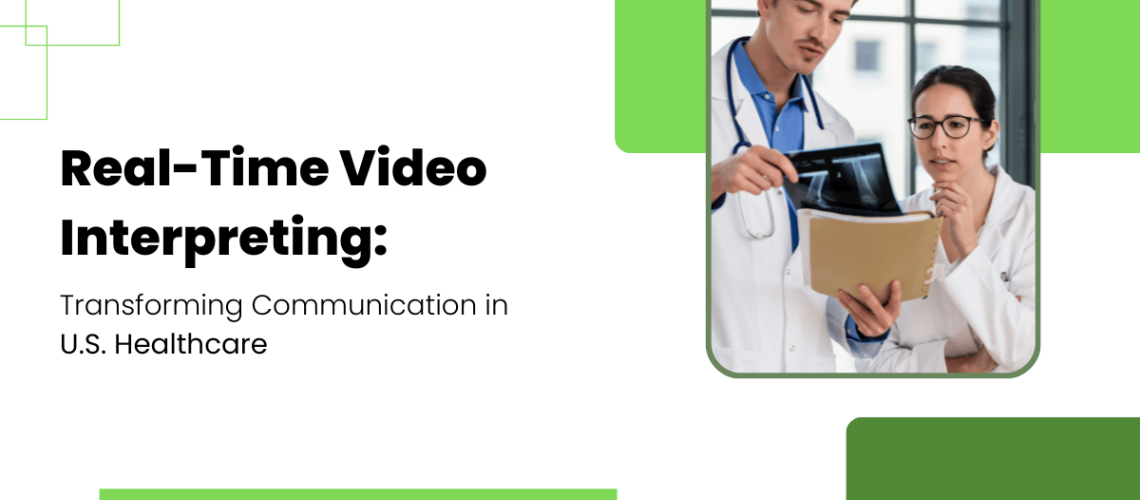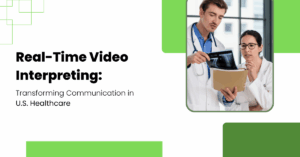In healthcare, every word matters. A single misunderstanding can change the course of treatment, delay care, or leave a patient feeling unheard. For many people across the United States, English is not their first language, and visiting a doctor or hospital can feel overwhelming. In those moments, communication is more than just important; it’s essential.
Real-time video interpreting has quickly become one of the most effective ways to close this communication gap. By allowing doctors, nurses, and patients to connect with professional interpreters instantly, healthcare providers can ensure that every conversation is clear, accurate, and compassionate. This simple yet powerful tool is changing the way healthcare is delivered across the country.
Why Real-Time Video Interpreting Matters
Healthcare has always been about trust. When a patient explains how they feel, they’re putting their health, and sometimes even their life, in someone else’s hands. If the patient and provider don’t share a common language, that trust can be difficult to build.
Phone interpreting has been a common solution for years, but it lacks the human element of face-to-face communication. Body language, facial expressions, and visual cues are all essential parts of how we communicate. Video interpreting brings those elements back into the conversation, helping patients feel seen and understood.
In urgent settings, such as emergency rooms or critical care, having immediate access to an interpreter can be life-changing. Instead of waiting for someone to arrive in person, providers can open a secure video link and begin communicating within moments.
Everyday Situations Where VRI Makes a Difference
Real-time video interpreting isn’t only for emergencies. It’s widley used across many areas of healthcare:
- Telehealth visits: As more appointments move online, interpreters can now join video calls seamlessly, ensuring patients at home have the same language support they would in a clinic.
- Primary care and family medicine: Parents explaining a child’s symptoms or elderly patients describing discomfort often rely on details and emotions that go beyond words. Video makes it easier for interpreters to capture these subtleties.
- Mental health services: In counseling and therapy, connection is everything. Video interpreting allows patients to feel engaged while keeping communication accurate and confidential.
- Specialist consultations: From prenatal visits to physical therapy, specialists often rely on detailed conversations with patients. VRI ensures that nothing gets lost in translation.
Benefits for Patients
For patients, real-time video interpreting means confidence. They can explain how they feel, ask questions, and understand the care they are receiving. Instead of guessing or relying on family members to interpret, they know they’re speaking through a trained professional who understands medical terminology and cultural nuances.
This creates a sense of comfort. A patient who feels understood is more likely to follow treatment plans, ask important questions, and build a stronger relationship with their healthcare team.
Benefits for Providers
For doctors and nurses, VRI makes communication smoother and reduces stress. Healthcare professionals don’t need to worry about whether their instructions are being understood correctly. Instead, they can focus fully on diagnosing and treating their patients.
It also saves valuable time. With instant access to interpreters, staff don’t have to wait for someone to arrive in person, nor do they have to rely on ad-hoc solutions like asking family members to interpret. That immediacy can make a huge difference in both urgent and routine care.
Moving Away from Family Interpreters
One of the biggest changes brought by VRI is reducing the reliance on family members as interpreters. While many families want to help, this approach often creates challenges. Sensitive information may not be shared fully, details might be misinterpreted, and children may be placed in situations they are not prepared for.
By offering professional video interpreting instead, providers create a safe, neutral space where patients can share openly. The interpreter’s role is clear: to communicate faithfully, without bias, and with complete confidentiality.
The Human Element of Video Interpreting
It’s easy to think of video interpreting as just another piece of technology, but at its core, it’s about people. Behind the screen is a trained interpreter who understands both the language and the cultural context of the conversation.
This human connection is what makes the service so powerful. A patient can see the interpreter’s face, hear their tone, and feel reassured that they are being listened to. It may not be in-person, but it is personal.
Overcoming Challenges
Like any tool, video interpreting does come with challenges. Some healthcare providers may face technical hurdles, such as poor internet connections, while others may be hesitant to adopt new processes. However, with the right preparation, these challenges are manageable.
Training staff, ensuring secure and reliable platforms, and building familiarity with the service are all steps that help organizations make VRI a natural part of patient care. Once integrated, most teams find that it quickly becomes indispensable.
Looking Ahead
The role of video interpreting in U.S. healthcare is only growing. As more communities become linguistically diverse and telehealth continues to expand, the demand for real-time, accessible interpretation will increase. What once might have been considered an optional service is now becoming a vital component of how care is delivered.
In the future, we can expect video interpreting to be even more integrated into everyday healthcare, connecting seamlessly with telemedicine platforms, patient records, and emergency response systems. But no matter how advanced the technology becomes, the heart of the service will remain the same: people helping people communicate when it matters most.
Conclusion
At the end of the day, healthcare is about human connection. When patients feel understood, they feel cared for. Real-time video interpreting allows providers to break down language barriers in ways that are immediate, accurate, and compassionate.
By combining technology with the skill of professional interpreters, U.S. healthcare providers are creating a system where every patient’s voice can be heard clearly and confidently. It’s not just about translation; it’s about trust, dignity, and better care for everyone.







